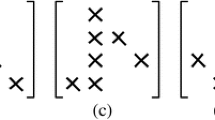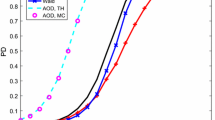Abstract
Recently developed subspace techniques for blind adaptive multiuser detection are briefly reviewed first. In particular, blind methods based on signal subspace tracking for adapting linear multiuser detectors in AWGN CDMA channels are considered, as well as extensions of these techniques to frequency selective fading channels, dispersive channels, and antenna array spatial processing. In addition, subspace‐based nonlinear adaptive techniques for robust blind multiuser detection in non‐Gaussian ambient noise channels are also described. Several new techniques are then developed within the subspace framework for blind joint channel estimation and multiuser detection, under some specific channel conditions. These include (1) an adaptive receiver structure for joint multiuser detection and equalization in dispersive CDMA channels, (2) a subspace method for joint multiuser detection and equalization in unknown correlated noise, and (3) a method for joint interference suppression and channel tracking in time‐varying fading channels.
Similar content being viewed by others
References
T.W. Anderson, An Introduction to Multivariate Statistical Analysis (Wiley, New York, 1984).
Y-H. Chen and C-T. Chiang, Kalman-based estimator for DOA estimation, IEEE Transactions on Signal Processing 42(12) (December 1994) 3543–3547.
C.E. Davila, An efficient recursive total least square algorithm for FIR adaptive filtering, IEEE Transactions on Signal Processing 42(2) (February 1994) 268–280.
A.P. Dempster, N.M. Laird and D.B. Rubin, Maximum likelihood from incomplete data via the EM algorithm, Journal of Royal Statistical Society 39 (1977) 1–38.
M. Honig, U. Madhow and S. Verdú, Blind adaptive multiuser detection, IEEE Transactions on Information Theory 41(4) (July 1995) 944–960.
M. Honig and H.V. Poor, Adaptive interference suppression, in: Wireless Communications: A Signal Processing Perspective, eds. H.V. Poor and G.W. Wornell (Prentice-Hall, Upper Saddle River, NJ, 1998) pp. 64–128.
P.J. Huber, Robust Statistics (Wiley, New York, 1981).
H.V. Poor and S. Verdú, Probability of error in MMSE multiuser detection, IEEE Transactions on Information Theory 43(3) (May 1997) 858–871.
H.V. Poor, An Introduction to Signal Detection and Estimation, 2nd edition (Springer-Verlag, 1994).
V.U. Reddy, B. Egardt and T. Kailath, Least squares type algorithm for adaptive implementation of Pisarenko's harmonic retrieval method, IEEE Transactions on Acoustics and Speech Signal Processing 30(3) (March 1982) 399–405.
C. Sengupta, J.R. Cavallaro and B. Aazhang, Subspace-based tracking of multipath channel parameters for CDMA systems, European Transactions on Telecommunications, Special Issue on CDMA, 9(5) (September/October 1998) 439–447.
P.A. Thompson, An adaptive spectral analysis technique for unbiased frequency estimation in the presence of white noise, in: Proc. 13th Asilomar Conf. on Circuits, Systems and Computers (1980) pp. 529–533.
S. Verdú, Multiuser Detection (Cambridge University Press, Cambridge, UK, 1998).
X. Wang and H.V. Poor, Adaptive joint multiuser detection and channel estimation in multipath fading CDMA channels, ACM/Baltzer/URSI Wireless Networks, Special Issue on Multiuser Detection in Wireless Communications, 4(6) (1998) 453–470.
X. Wang and H.V. Poor, Robust multiuser detection in non-Gaussian channels, IEEE Transactions on Signal Processing 47(2) (February 1999) 289–305.
X. Wang and H.V. Poor, Blind adaptive multiuser detection in multipath channels based on subspace tracking, IEEE Transactions on Signal Processing 46(11) (November 1998) 3030–3044.
X. Wang and H.V. Poor, Blind equalization and multiuser detection for CDMA communications in dispersive channels, IEEE Transactions on Communications 46(1) (January 1998) 91–103.
X. Wang and H.V. Poor, Blind multiuser detection: A subspace approach, IEEE Transactions on Information Theory 44(2) (March 1998) 677–691.
C.F. Wu, On the convergence properties of the EM algorithm, The Annals of Statistics 11(1) (1983) 95–103.
Q. Wu and K.M. Wong, UN-MUSIC and UN-CLE: An application of generalized correlation analysis to the estimation of the direction of arrival of signals in unknown correlated noise, IEEE Transactions on Signal Processing 42(9) (September 1994) 2331–2343.
B. Yang, Projection approximation subspace tracking, IEEE Transactions on Signal Processing 44(1) (January 1995) 95–107.
Y.F. Yang and M. Kaveh, Adaptive eigensubspace algorithms for direction or frequency estimation and tracking, IEEE Transactions on Acoustics and Speech Signal Processing 36(6) (June 1988) 241–251.
Author information
Authors and Affiliations
Rights and permissions
About this article
Cite this article
Wang, X., Poor, H.V. Subspace methods for blind joint channel estimation and multiuser detection in CDMA systems. Wireless Networks 6, 59–71 (2000). https://doi.org/10.1023/A:1019156607515
Issue Date:
DOI: https://doi.org/10.1023/A:1019156607515




